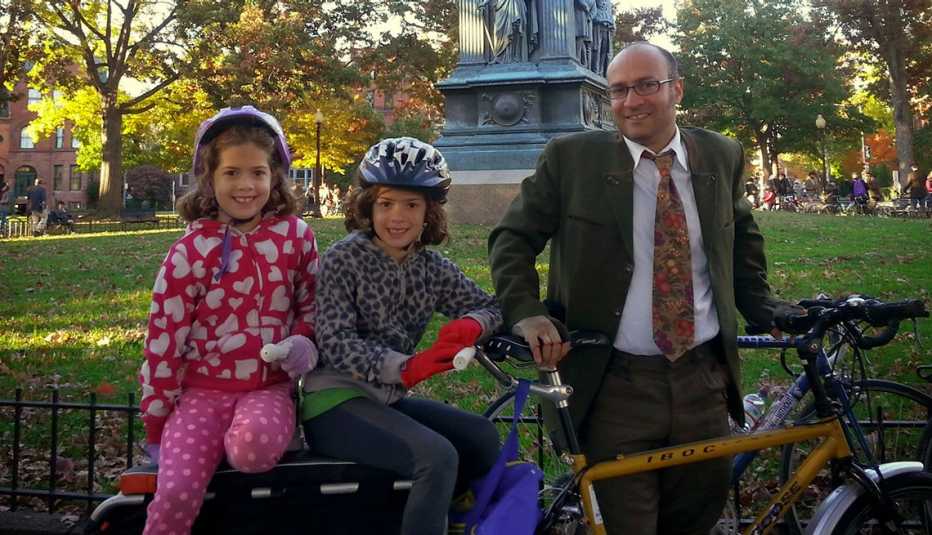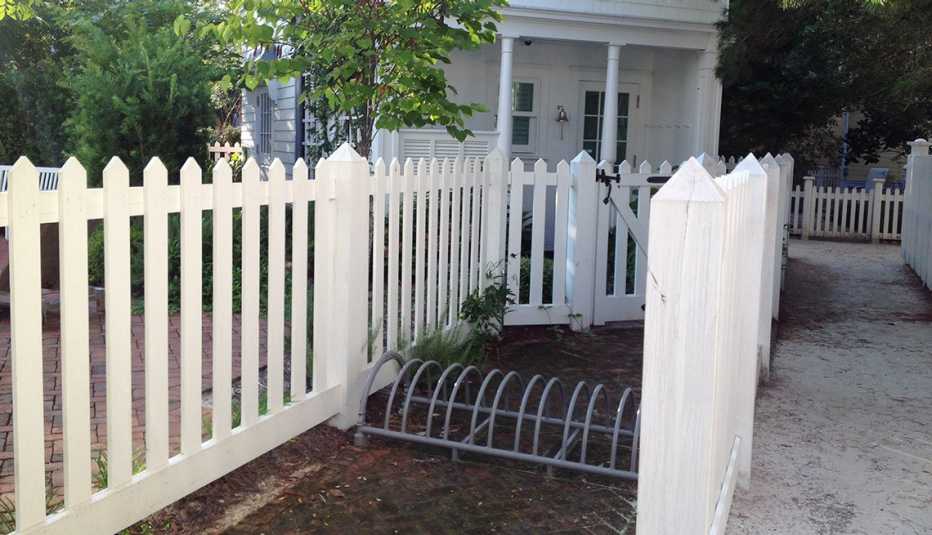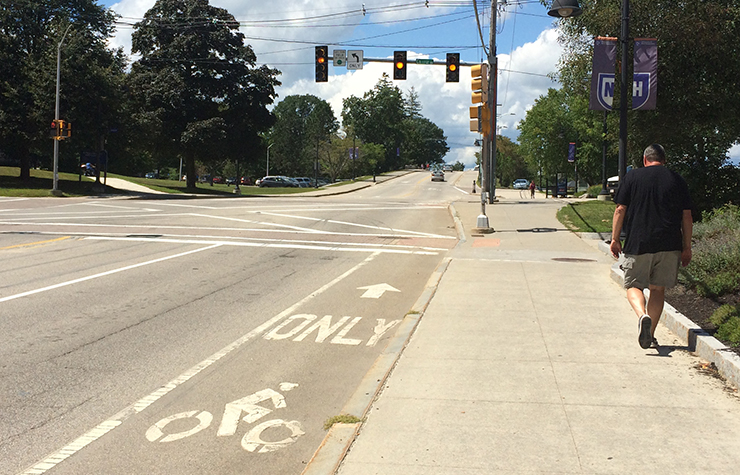AARP Hearing Center


Even in the most crime-free of America's neighborhoods, people don't feel entirely safe when they're out and about. Drivers, some of whom view the nation's roadways as their exclusive domain, are having to contend with growing numbers of bicyclists and pedestrians.
Bicyclists, who are largely focused on maneuvering through vehicle traffic and not getting sideswiped on shoulderless streets, sometimes don't realize how they imperil pedestrians. People traveling by foot often feel under siege from both speeding cars and unpredictable bicycles. Like many street-level conflicts, this one is about territory. Who owns the streets?
But shared custody is possible. After all, each of these adversaries fits into more than one camp.
- Drivers are also walkers
- Drivers and walkers may also be bicyclists
- Bicyclists can also be walkers and drivers
The solution (and key to reducing frustration and preventing actual injury) is to share the streets by providing a space for each group. Recent research shows that bicycle-friendly projects are even good for people who will never ride a bike. Here's how:
1. Safer Streets Are Safer For Everyone
"One of the things we've found with bike infrastructure is that it makes streets safer for everyone, not just bicyclists," explains Barbara McCann, director of Safety, Energy & Environment for the U.S. Department of Transportation (USDOT). "It reduces the frequency of crashes. It calms traffic, which makes streets less chaotic and safer for everyone."
Adds Dan Burden, a community vitality consultant with Blue Zones — and the founder of the Walkable and Livable Communities Institute — who has worked in 3,500 towns and neighborhoods across North America: "I've always said the reason for bikeways is not what they do for bicyclists, but what they do for the whole community. They're great for drivers because they make it safer to get in and out of parked cars. They're great for walkers because it creates more distance between the sidewalk and speeding vehicles."


Ken McLeod of the The League of American Bicyclists points out that "bike lanes of any kind calm traffic by reducing the width of the road, which signals to motorists that they should drive more carefully. Bike lanes also reduce the distance pedestrians are in contact with motor vehicles while crossing the street."
Across New York City, injuries for motorists, pedestrians and bicyclists declined by 20 percent on streets with protected bike lanes. The same holds true in the city of Arlington, Virginia, outside Washington, D.C. Between 2006 and 2014, as Arlington implemented its Complete Streets program and added infill development, there was a 50 percent decline in injuries among all users on streets, notes Dennis Leach, the director of transportation for Arlington County.
2. Safer Sidewalks
Marvin R. Anderson, a community leader in St. Paul, Minnesota, underscores the importance of bike lanes to older people in his neighborhood.
"It's not just cars and crime you have to be careful about, but also bikes. We need to separate the cars, the bikes and the pedestrian, like they do on Copenhagen's streets."


Shari Schaftlein, a human environment director with the Federal Highway Administration, explains: "If there's a safe and comfortable facility where people can ride, we get bikes off the sidewalks — where they can be very dangerous for pedestrians and the disabled. Also, it's easier for police to enforce laws against riding on the sidewalk when there's a viable alternative."
3. Smoother Trips
"The anxiety and anger that many people have about bicyclists is because we have streets designed for conflict," observes Randy Neufeld, director of the SRAM Cycling Fund. "Everyone is nervous because no one knows where the bikes belong. Protected bike lanes take that chaos and disorganization away. We're not all fighting over the same space."


In fact, says Martha Roskowski of People For Bikes, defining spaces is the reason why research shows that drivers like protected bike lanes: "It increases the predictability of bicyclists by giving them their own place in the streets."
"If you actually give bicyclists a designated place in the road, they behave in a way that's more conducive for everyone getting along," adds Jim Merrell, campaign manager for the Chicago Active Transportation Alliance. He points to findings that bicyclists stop for red lights 161 percent more often at special bike signals along the protect lanes of the city's busy Dearborn Avenue.
And improved civility goes both ways. A study of protected lanes on Chicago's Kinzie Street shows that half of cyclists reported improved motorist behavior.
4. Less Congestion
It makes sense that having more people on bicycles will lead to less roadway congestion. However, a study by researchers at the University of Virginia finds that increased bike riding across America could mean more congestion if bike lanes are not included on busy streets.
For instance, even with a growing overall population, Arlington, Virginia, is seeing a 15 to 20 percent decline in traffic on some of its arterial streets, with the biggest decreases in areas that are the most bikable and walkable, says transportation director Leach.
"Our goal is to give all residents, workers and visitors a range of viable travel options," he explains, noting that the county now boasts 50 miles of off-road bicycle paths and 36 miles of bike lanes, including 1.5 miles of protected bike lanes with more to come.


5. Increasingly Livable Communities
"Bicycling makes cities more attractive," explains Gil Penalosa, founder of 8 80 Cities, which promotes making community livability for people of all ages. "The quality of the air is better and the amount of noise is less. You're more likely to know your neighbors and stop for a conversation."
Arlington's Leach notes that neighborhoods with bike lanes are often "filled with people on the streets going to stores, sitting in cafes."
6. Economic Vitality
One of America's most ambitious bicycling projects is Indianapolis' Cultural Trail, an 8-mile network of separated bike and pedestrian lanes that has reinvigorated a number of struggling business districts and sparked a whopping $1 billion in increased property values. The Cultural Trail has also bestowed considerable cachet on this often-overlooked city.
"The trail is putting Indianapolis on the map as a place to see bold innovation," reported the New York Times, and in 2014 the paper's Travel section selected Indy as number 34 in its annual "52 Places to Go" list.
Sharing the Road
Protected Bike Lanes physically separate bicyclists from motorists and pedestrians on busy streets. (Think of them as sidewalks for bicyclists.)
Off-Road Bike Paths are essentially walkways and trails that people use in parks and vehicle-free areas.
Bicycle Boulevards, also known as Neighborhood Greenways, are low-traffic streets where bicyclists and walkers get priority over motorists.
Companies increasingly want to locate in bicycle-friendly places as a way to attract the young workers they need in order to thrive, especially in competitive tech and creative fields. Chicago is vigorously building bikeways as part of its pursuit of high-tech businesses, a strategy that paid off when Motorola Mobility decamped from the suburbs to a new headquarters near the city's first protected bike lane.
The large advertising firm Colle+McVoy moved to downtown Minneapolis, as CEO Christine Fruechte explains, "to allow our employees to take advantage of the area's many trails and to put the office in a more convenient location for commuting by pedal or foot. Our employees are healthier, happier and more productive. We are attracting some of the best talent in the industry."
Austin, Texas, is ambitiously expanding its bike infrastructure and has become one of the nation's leaders in protected bike lanes. Cirrus Logic, a computer company, moved downtown several years ago because the area's bike trails and protected lanes made the firm "more attractive as an employer," explains Public Relations Director Bill Schnell. "We can't just pluck anybody for our jobs. The people we want are mostly younger, and biking is part of the equation for them."
Memphis is also pushing protected bike lanes. "My job is to convince emerging companies that they can get the workers they want to come here. The bike is part of the overall strategy to compete for talent," offers Steven J. Bares, Ph.D., president of the Memphis Bioworks Foundation, an initiative to bring fast-growing health care companies to Memphis.
7. More Opportunity
Marvin R. Anderson, a retired lawyer, has spent much of his life working to boost St. Paul's African-American community. "Encouraging bicycling and walking are important to reweaving the Rondo neighborhood," Anderson says about the once-thriving, tight-knit community that was displaced and destroyed in the 1960s by construction of Interstate 94. "Biking and walking are healthy. Biking and walking can save people money. We need to create a culture of biking and walking."
Barbara McCann of USDOT notes, "Safe bicycling conditions provide low-income Americans with an opportunity to get to jobs, education, stores and transit so they don't have to pull together a lot of money to buy a car."
Being able to thrive without a car is essential to many African-Americans, one-third of who have no access to a car, and Latinos, one-quarter of who are carless, according to a report by the Leadership Conference Education Fund. For individuals who don't own a car or have access to one, bicycling represents important pathways to opportunity.


"A big thing we could do to help low-income families is to make it easier to live without a car," says Gil Penalosa of 8 80 Cities. "And it would help middle class families to switch from two cars to one." He adds that the average cost of owning and operating one car is still $8,500 a year, even after the recent slide in gasoline prices.
8. Saves Money For Taxpayers
In an era when streets and sidewalks across the country are in disrepair, bicycle projects can save us a bundle in maintaining and expanding our transportation systems.
Even protected bike lanes are "dirt cheap to build compared to road projects," says Gabe Klein, a partner at Fontinalis, a venture capitalist firm founded by Ford Motor Co. Chairman Bill Ford.
When he was the transportation commissioner in Washington, D.C., and, later, Chicago, Klein launched two of the nation's most ambitious programs for building innovative bike projects.


R.T. Rybak, mayor of Minneapolis from 2001 to 2013, now CEO and president of the Minneapolis Foundation, stresses that cities everywhere need to be more efficient about the money they spend to move people. "We need to get more use from the streets we already have," Rybak said. "It really is the idea that bikes belong."
9. Health Care Savings
The health benefits of bicycling look almost like a miracle. Moderate physical exercise such as bicycling for only 30 minutes a day reduces a person's chances of diabetes, dementia, depression, colon cancer, cardiovascular disease, anxiety and high blood pressure by 40 percent or more.
Since tens of millions of Americans receive their health care from federal, state and local governments (i.e., Medicare, Medicaid, military and public employees' health plans), an American taxpayer who never pedals a bike will still enjoy economic benefits if other people do.


Employees and shareholders at businesses have a stake in bicycling, too.
QBP a large bicycle products distributor in suburban Minneapolis, encourages its employees to bike to work through a series of generous incentives, which cost the company $45,000 a year. However, QBP figured it was the right thing to do since the company makes its money from bicycling. Turns out, it was the right thing to do for economic reasons as well. The firm's health care costs dropped 4.4 percent in the first two years, which translated into $200,000 a year in savings. By contrast, other companies suffered an average 25 percent jump in health care costs over the same period.
10. A Greener Environment
Transportation accounts for more than a quarter of all greenhouses gases, the second largest sector after electricity (30 percent), according to the U.S. Environmental Protection Agency.
A study from the Worldwatch Institute found that swapping a car for a bike on short commutes of four miles to work and back would generate 2,000 less pounds of carbon every year — which adds up to a five percent reduction in the carbon footprint of an average American.


Living a Car-Free Life
Avid bicyclist Roslyn Rubin (featured in the article "Why Older Americans Should Give Up Their Cars") has lived without a car for more than 20 years in Arlington, Virginia.
More bicycles on the streets and fewer cars also lessen other forms of air and noise pollution.
P.S. People of All Ages Like to Bicycle
Contrary to myth, bikes aren't only for kids, and bicycling as a means of exercise and transportation is not the sole purview of young, male, ultra-fit daredevils.
As street-level bicycling infrastructure improves and expands, the number of older, younger, female and inexperienced bicyclists is rising, notes Martha Roskowski, vice president of PeopleForBikes. "The biggest jump we're seeing in biking is among older people," Roskowski says.
Riders age 50 and over pedaled an estimated 2.6 billion miles rides in 2009, according to the latest data from the National Household Travel Survey conducted by the USDOT. That's more than a six-fold increase from 1995, when that age group covered less than 400 million miles.
Jay Walljasper, author of "The Great Neighborhood Book," consults, writes and speaks about making communities healthier and happier for everyone.
Published September 2016
RELATED ARTICLE: Street-Level Solutions for Safer Cycling































































